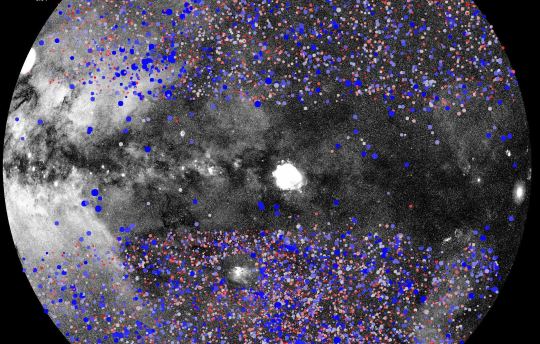#eROSITA
Text
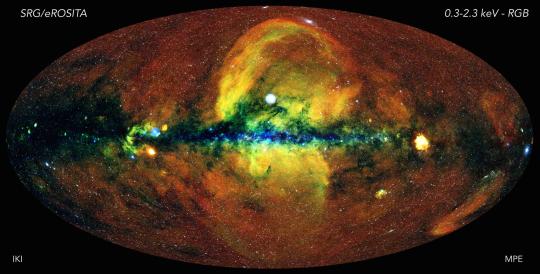
The universe as seen with the eROSITA X-ray telescope
As eROSITA scans the sky, the energy of the collected photons is measured with an accuracy ranging from 2% – 6%.
To generate this image, in which the whole sky is projected onto an ellipse (so-called Aitoff projection) with the center of the Milky Way in the middle and the body of our Galaxy running horizontally, photons have been color-coded according to their energy (red for energies 0.3-0.6 keV, green for 0.6-1 keV, blue for 1-2.3 keV).
The red diffuse glow away from the galactic plane is the emission of the hot gas in the vicinity of the Solar System (the Local Bubble). Along the plane itself, dust and gas absorb the lowest energy X-ray photons, so that only high-energy emitting sources can be seen, and their color appears blue in the image.
The hotter gas close to the Galactic center, shown in green and yellow, carries imprinted the history of the most energetic processes in the life of the Milky Way, such as supernova explosions, driving fountains of gas out of the plane, and, possibly, past outburst from the now dormant supermassive black hole in the center of the Milky Way.
Piercing through this turbulent, hot diffuse medium, are hundreds of thousands of X-ray sources, which appear mostly white in the image, and uniformly distributed over the sky. Among them, distant active galactic nuclei are visible as point sources, while clusters of galaxies reveal themselves as extended X-ray nebulosities.
In total, about one million X-ray sources have been detected in this image.
Image credit: Jeremy Sanders, Hermann Brunner & the eSASS team / Max Planck Institute for Extraterrestrial Physics / Eugene Churazov & Marat Gilfanov, IKI.
#art#cosmos#cosmic#universe#blast#wallpaper#photography#x_ray#eROSITA#telescope#x-ray telescope#aitoff projection#space#stars#space wallpaper#universe wallpaper
47 notes
·
View notes
Text
Descubriendo el Universo Invisible: La Importancia de la Astronomía de Rayos
En el vasto universo que nos rodea, existe una realidad invisible a simple vista pero fundamental para comprender la complejidad del cosmos: la radiación de rayos X. En este artículo, exploraremos el fascinante campo de la astronomía de rayos X, centrándonos en la misión eROSITA y su impacto en la comprensión de los objetos de alta energía, incluyendo agujeros negros, estrellas de neutrones y…

View On WordPress
0 notes
Text
Voor het eerst is de röntgenflits waargenomen van de nova van een witte dwerg
Voor het eerst is de röntgenflits waargenomen van de nova van een witte dwerg
Impressie van de waargenomen röntgenflits van de nova. Credit: Annika Kreikenbohm
Als sterren zoals de zon aan het einde van hun leven zijn gekomen en de brandstof in hun kern op is krimpen ze ineen tot witte dwergen. Die kunnen op hun beurt exploderen tot nova of in sommige gevallen zelfs tot supernova als ze door toevoer van materie van een naburige ster zwaar worden, té zwaar. In het geval van…

View On WordPress
0 notes
Text
Voor het eerst is de röntgenflits waargenomen van de nova van een witte dwerg
Voor het eerst is de röntgenflits waargenomen van de nova van een witte dwerg
Impressie van de waargenomen röntgenflits van de nova. Credit: Annika Kreikenbohm
Als sterren zoals de zon aan het einde van hun leven zijn gekomen en de brandstof in hun kern op is krimpen ze ineen tot witte dwergen. Die kunnen op hun beurt exploderen tot nova of in sommige gevallen zelfs tot supernova als ze door toevoer van materie van een naburige ster zwaar worden, té zwaar. In het geval van…
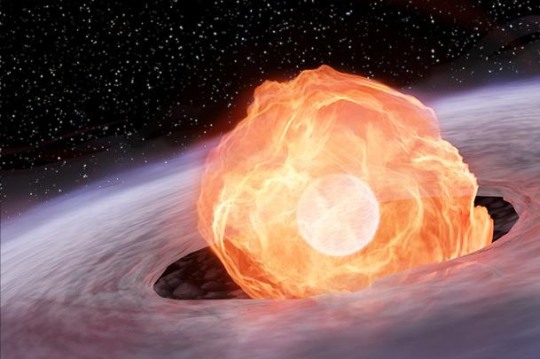
View On WordPress
0 notes
Text

New SpaceTime out Monday....
SpaceTime 20240318 Series 27 Episode 34
Starship almost aces it’s third test flight
The world’s largest and most powerful rocket SpaceX’s Starship superheavy has completed a mostly successful test flight.
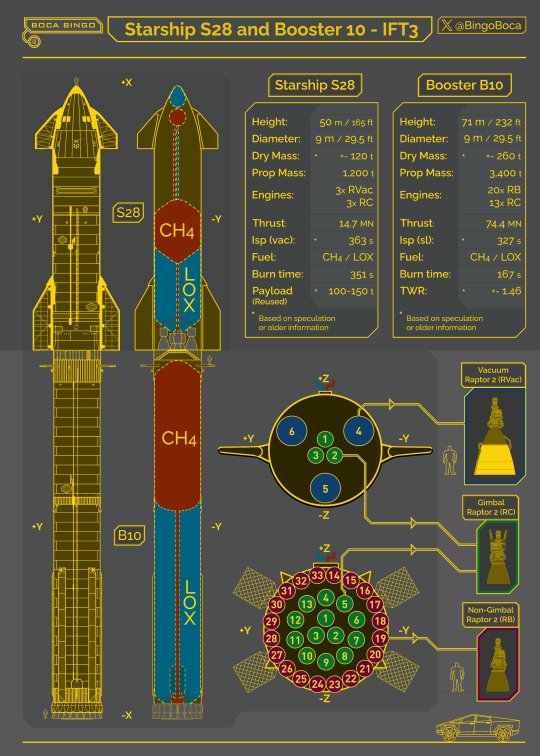















Is Voyager 1’s mission over?
NASA’s Voyager 1 is the most-distant man-made object in space and is more than 24 billion kilometres away. However, the first spacecraft to cross into interstellar space is not doing well and its days seem numbered as it’s been sending back incoherent messages to mission managers since November and scientists don’t know why.

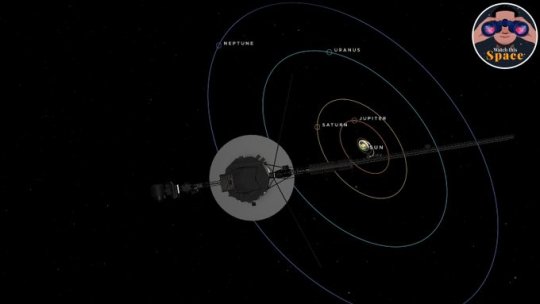


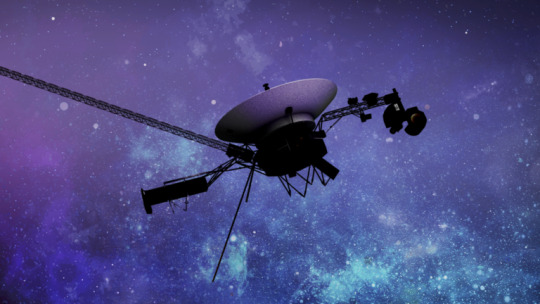

Astronomers get a clearer picture of the high energy universe
Astronomers have been given a clearer picture of the high energy X-ray sky thanks to the first all-sky survey data release by the eROSITA telescope.



Rocket Lab launches its 45th Electron rocket
Rocket Lab has successfully launch of its 45th Electron rocket placing another earth observation satellite into orbit.




The Science Report
Claims kids in the outer suburbs of Australia’s biggest cities are twice as likely to have asthma.
A new study suggests small amount of apple cider vinegar every day may help you lose weight
Scientists show Australian Magpies get their smarts thanks to nurture rather than nature.
Skeptics guide the dangers of Hydroxychloroquine
SpaceTime covers the latest news in astronomy & space sciences.
The show is available every Monday, Wednesday and Friday through Apple Podcasts (itunes), Stitcher, Google Podcast, Pocketcasts, SoundCloud, Bitez.com, YouTube, your favourite podcast download provider, and from www.spacetimewithstuartgary.com
SpaceTime is also broadcast through the National Science Foundation on Science Zone Radio and on both i-heart Radio and Tune-In Radio.
SpaceTime daily news blog: http://spacetimewithstuartgary.tumblr.com/
SpaceTime facebook: www.facebook.com/spacetimewithstuartgary
SpaceTime Instagram @spacetimewithstuartgary
SpaceTime twitter feed @stuartgary
SpaceTime YouTube: @SpaceTimewithStuartGary
SpaceTime -- A brief history
SpaceTime is Australia’s most popular and respected astronomy and space science news program – averaging over two million downloads every year. We’re also number five in the United States. The show reports on the latest stories and discoveries making news in astronomy, space flight, and science. SpaceTime features weekly interviews with leading Australian scientists about their research. The show began life in 1995 as ‘StarStuff’ on the Australian Broadcasting Corporation’s (ABC) NewsRadio network. Award winning investigative reporter Stuart Gary created the program during more than fifteen years as NewsRadio’s evening anchor and Science Editor. Gary’s always loved science. He studied astronomy at university and was invited to undertake a PHD in astrophysics, but instead focused on his career in journalism and radio broadcasting. He worked as an announcer and music DJ in commercial radio, before becoming a journalist and eventually joining ABC News and Current Affairs. Later, Gary became part of the team that set up ABC NewsRadio and was one of its first presenters. When asked to put his science background to use, Gary developed StarStuff which he wrote, produced and hosted, consistently achieving 9 per cent of the national Australian radio audience based on the ABC’s Nielsen ratings survey figures for the five major Australian metro markets: Sydney, Melbourne, Brisbane, Adelaide, and Perth. The StarStuff podcast was published on line by ABC Science -- achieving over 1.3 million downloads annually. However, after some 20 years, the show finally wrapped up in December 2015 following ABC funding cuts, and a redirection of available finances to increase sports and horse racing coverage. Rather than continue with the ABC, Gary resigned so that he could keep the show going independently. StarStuff was rebranded as “SpaceTime”, with the first episode being broadcast in February 2016. Over the years, SpaceTime has grown, more than doubling its former ABC audience numbers and expanding to include new segments such as the Science Report -- which provides a wrap of general science news, weekly skeptical science features, special reports looking at the latest computer and technology news, and Skywatch – which provides a monthly guide to the night skies. The show is published three times weekly (every Monday, Wednesday and Friday) and available from the United States National Science Foundation on Science Zone Radio, and through both i-heart Radio and Tune-In Radio.
#science#space#astronomy#physics#news#nasa#esa#astrophysics#spacetimewithstuartgary#starstuff#spacetime#cosmos
11 notes
·
View notes
Text
CAN A STAR SURVIVE A BLACK HOLE??
Blog#266
Saturday, January 28th, 2023
Welcome back,
A captured star has experienced multiple close encounters with a supermassive black hole in a distant galaxy — and possibly even survived having material ripped away by immense gravitational tidal forces.
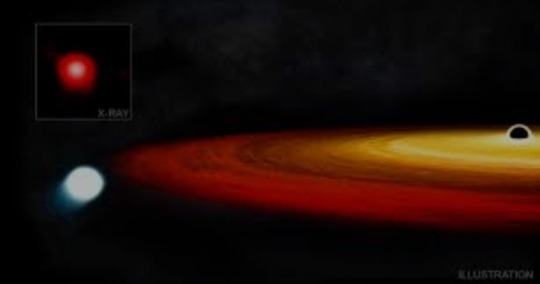
The destruction of a star by the gravitational forces of a supermassive black hole is a violent affair known as a tidal disruption event (TDE). Gas is torn from the star and undergoes "spaghettification," in which it is shredded and stretched into streams of hot material that flow around the black hole, forming a temporary and very bright accretion disk.
From our point of view, the center of the galaxy housing the supermassive black hole seems to flare.

On Sept. 8, 2018, the All-Sky Automated Survey for Supernovae (ASASSN) spotted a flare in the nucleus of a distant galaxy 893 million light-years away. Cataloged as AT2018fyk, the flare had all the hallmarks of a TDE. Various X-ray telescopes, including NASA's Swift, Europe's XMM-Newton, the NICER instrument mounted to the International Space Station, and Germany's eROSITA, observed the black hole brightening dramatically.
Ordinarily, TDEs exhibit a smooth decline in brightness over several years, but when astronomers looked again at AT2018fyk about 600 days after it had first been noticed, the X-rays had quickly vanished. Even more puzzling, about 600 days after that, the black hole suddenly flared up again. What was going on?
"Until now, the assumption has been that when we see the aftermath of a close encounter between a star and a supermassive black hole, the outcome will be fatal for the star; that is, the star is completely destroyed,"
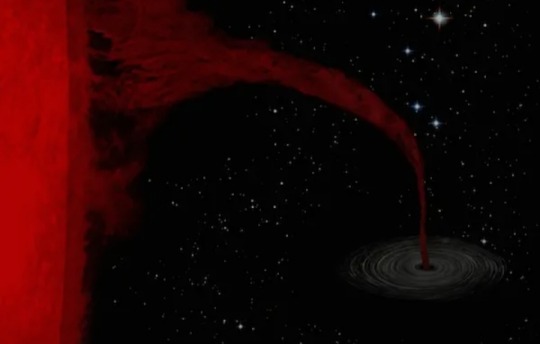
Thomas Wevers, an astronomer at the European Southern Observatory and an author of new research about the event, said in a statement. "But contrary to all other TDEs we know of, when we pointed our telescopes to the same location again several years later, we found that it had re-brightened."
Wevers led a team of astronomers who realized that the repeated flares were the signature of a star that had survived a TDE and completed another orbit to experience a second TDE.

To fully explain what they were observing, Wevers' group developed a model of a "repeating partial TDE."
In their model, the star was once a member of a binary system that passed too close to the black hole at the center of its galaxy. The black hole's gravity flung one of the stars away, which transformed into a runaway hypervelocity star racing at 600 miles (1,000 kilometers) per second out of the galaxy.
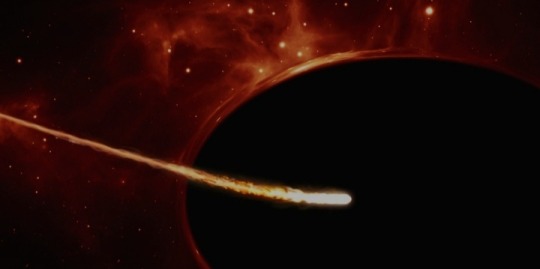
The other star became tightly harnessed to the black hole, on a 1,200-day elliptical orbit that took it toward what scientists call the tidal radius — the distance from the black hole at which a star starts to be ripped apart by the gravitational tides emanating from the black hole.
Originally published on space.com
COMING UP!!
(Wednesday, February 1st, 2023)
"WHAT IS A COSMOLOGICAL WALL"??
#astronomy#outer space#alternate universe#astrophysics#spacecraft#universe#white universe#space#parallel universe#astrophotography#stars#cosmology
56 notes
·
View notes
Text
Arroja análisis de Galaxias en rayos X tensión permanente en el Universo
Los resultados del primer estudio del cielo con rayos X de @eROSITA_SRG revelaron la inconsistencia anterior entre mediciones competitivas de la estructura del Universo.
Agencias/Ciudad de México.- Un nuevo análisis de cómo evolucionan los cúmulos de galaxias a lo largo del tiempo ha arrojado mediciones precisas de la cantidad total de materia en el Universo y su grado de aglomeración.
Estos y otros hallazgos fueron reportados en una serie de artículos publicados por científicos del consorcio alemán eROSITA, dirigido por el Instituto Max Planck de Física…

View On WordPress
0 notes
Link
Cosmologists are wrestling with an interesting question: how much clumpiness does the Universe have? There are competing but not compatible measurements of cosmic clumpiness and that introduces a “tension” between the differing measurements. It involves the amount and distribution of matter in the Universe. However, dark energy and neutrinos are also in the mix. Now, results from a recent large X-ray survey of galaxy clusters may help “ease the tension”. The eROSITA X-ray instrument orbiting beyond Earth performed an extensive sky survey of galaxy clusters to measure matter distribution (clumpiness) in the Universe. Scientists at the Max Planck Institute for Extraterrestrial Physics recently shared their analysis of its cosmologically important data. “eROSITA has now brought cluster evolution measurement as a tool for precision cosmology to the next level,” said Dr. Esra Bulbul (MPE), the lead scientist for eROSITA’s clusters and cosmology team. “The cosmological parameters that we measure from galaxy clusters are consistent with state-of-the-art cosmic microwave background, showing that the same cosmological model holds from soon after the Big Bang to today.” eROSITA, the Standard Cosmological Model, and Clumpiness To get a better feel for what this means, let’s look at what the team is trying to confirm. The idea is to figure out just what the Universe has been like through time. That means understanding matter, its distribution (or clumpiness), and what role dark matter and dark energy have played. It all began just after the Big Bang when the Universe was in a hot, dense state. The only things existing were photons and particles. The Universe expanded and began to condense into regions of higher density. Think of these as density variations, or areas of more or less clumpiness in the primordial soup. As things cooled and expanded, the denser clumps in the soup became galaxies and eventually galaxy clusters. The clumpiness was smoother (or “isotropic”) than expected. That raises questions about the role of dark matter and dark energy, among other things. eROSITA’s observations of galaxy clusters and distribution of matter showed several interesting results. First, both dark matter and visible matter (baryonic matter), make up about 29 percent of the total energy density of the Universe. Presumably, the rest consists of dark energy, which we don’t know much about, yet. Energy density is the amount of energy stored in a region of space as a function of volume. In cosmology, it also includes any mass in that volume of space. This plot shows the constraints put on the total matter density in the Universe and the S8 “tension”. Constraints from eROSITA galaxy clusters are in orange, from the Cosmic Microwave Background (Planck) in blue, from weak lensing (DES+KiDS) in grey, and from cluster number counts (SPT) in black. Credit: MPE, V. Ghirardini for the eROSITA consortium The measurement of energy density agrees with measurements of the cosmic microwave background radiation—also known as the CMB. Think of that as a map of the density variations in the early Universe. It’s made up of microwave radiation that permeates the Universe. That radiation is not completely smooth or uniform. That’s the variability in density that eventually became the seeds of the first galaxies. Measuring Clumpiness eROSITA’s goal is to measure the assembly of galaxy clusters over cosmic time. By tracing their evolution via the X-rays emitted by hot gas, the instrument traced both the total amount of matter in the Universe and its clumpiness. Those measurements solve the “tension” or discrepancy between past clumpiness measurements that used different techniques. Those included the CMB and observations of weak gravitational lensing. A computer simulation of what gas and stars in a galaxy cluster look like, and how they look embedded in the cosmic web. The assembly of galaxy clusters has implications for the clumpiness of the Universe throughout time. Credit: Yannick Bahé. The eROSITA data shows the distribution of matter is actually in good agreement with previous measurements of the CMB. That’s good news because cosmologists were afraid they’d have to invoke “new physics” to explain the tension between measurements. “eROSITA tells us that the Universe behaved as expected throughout cosmic history,” says Dr. Vittorio Ghirardini, the postdoctoral researcher at MPE who led cosmology study. “There’s no tension with the CMB. Maybe the cosmologists can relax a bit now.” But Wait, There are Neutrinos to Worry About! Interestingly, the eROSITA measurements of galaxy clusters and other large structures also provide information about neutrinos. They’re the most abundant particles with mass that we know of in the Universe. They come from the Sun and supernovae (for example), but also originated in the Big Bang. eROSITA’s survey offers new information about the mass of neutrinos and their prevalence. “We have obtained tight constraints on the mass of the lightest known particles from the abundance of the largest objects in the Universe,” said Ghirardini. Computer simulations show how neutrinos can form cosmic clumpiness. Credit: Yoshikawa, Kohji, et al Neutrinos may be small and tough to “see”, but they have mass that contributes to the total density of matter in the Universe. Cosmologists describe them as “hot”, which means they travel at nearly the speed of light. Therefore, they tend to smooth out the distribution of matter—which can be probed by analyzing the evolution of galaxy clusters in the Universe. And, there’s a good chance that eROSITA may help solve the mystery of neutrino mass. “We are even on the brink of a breakthrough to measure the total mass of neutrinos when combined with ground-based neutrino experiments,” added Ghirardini. How eROSITA Did It There’s a lot more to explore in the eROSITA data, but it’s also fascinating to look at the extent of the survey data. It comprises one of the most extensive catalogs of clusters of galaxies done so far. The so-called “Western Galactic half” of the all-sky survey contains 12,247 optically identified X-ray galaxy clusters. “Of these, 8,361 represent new discoveries – almost 70%,” said Matthias Kluge, a postdoctoral researcher at MPE who is responsible for the optical identification of the detected clusters. “This shows the huge discovery potential of eROSITA.” All that data can be charted in three dimensions, and when scientists do that, galaxy clusters show up as intersections of the cosmic web. In addition, there’s a supercluster catalog, which also shows connected clusters and the filaments of matter between them. “We find more than 1,300 supercluster systems, which makes this the largest-ever X-ray supercluster sample,” said Ang Liu, a postdoctoral researcher at MPE. This new look at clumpiness in the Universe comes from the first release of data from eROSITA. The instrument completed additional surveys in early 2022. Once those data are analyzed, astronomers expect to be probing even deeper into the distribution of matter in the Universe and testing their models against reality. “When the full data are analyzed,” said Esra Bulbul, “eROSITA will again put our cosmological models to the most stringent test ever conducted through a cluster survey.” For More Information eROSITA Relaxes Cosmological TensionThe SRG/eROSITA All-Sky Survey: Cosmology Constraints from Cluster Abundances in the Western Galactic Hemisphere About eROSITA The post A New, More Accurate Measurement for the Clumpiness of the Universe appeared first on Universe Today.
1 note
·
View note
Text
Le misure del cielo a raggi X di eROSITA mostrano coerenza con il fondo cosmico a microonde
Immagini ottiche che mostrano le galassie in direzione di quattro ammassi di galassie a distanze diverse. L’emissione di raggi X del gas caldo negli ammassi è mostrata in blu.
L’analisi del modo in cui gli ammassi di galassie, gli oggetti più grandi dell’universo, si evolvono nel corso del tempo cosmico ha fornito misure precise del contenuto totale di materia e del suo raggruppamento,…

View On WordPress
0 notes
Text
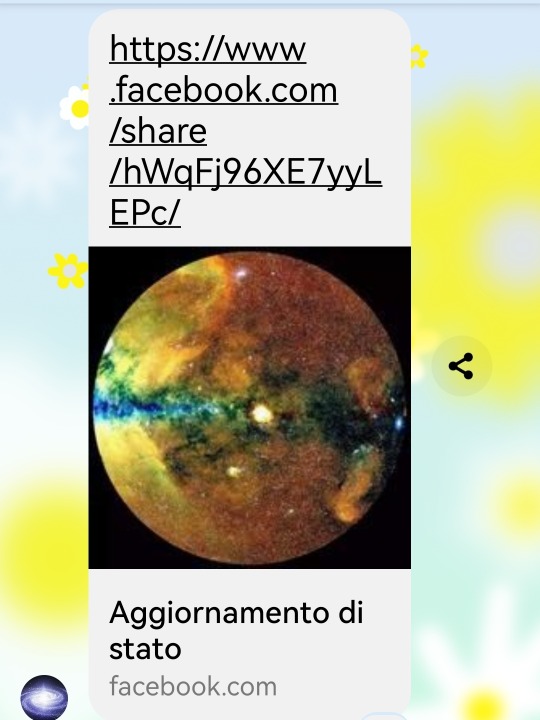
Novo censo da #Matéria no Universo!
A mais recente imagem do Universo em #raios-X foi recém liberada pela "Missão e-ROSITA", que detectou mais de 1 milhão de fontes de raios-X, muitas delas pela PRIMEIRA VEZ.
Estas fontes incluem o gás quente de mais de 12 mil aglomerados de galáxias e mais de 900 mil buracos negros supermassivos.
Estes dados fornecem um novo censo da quantidade de matéria e de como ela se distribui no Universo, e fornecem vínculos importantes para a matéria e energia escuras.
Estes resultados estão sendo discutidos em uma série de artigos científicos publicados ontem, na sua maioria liderados pelos cientistas do MPE - Max Plack Institute for Extraterrestrial Physics.
by: Astrofisica Thaisa Storchi Bergmann
#eROSITA #astronomia #ciencia #universo #raios-X
☆
Rita Vidigal Astronomy
0 notes
Text

Clusters of galaxies
As seen by the eROSITA All-Sky Survey with red dots indicating redshift 1 objects and blue dots indicating redshift 3 objects.
Image credit: MPE, J. Sanders for the eROSITA consortium
#art#cosmos#cosmic#universe#blast#space#wallpaper#photography#galaxies#galaxy#clusters#eROSITA#MPE#J.sanders#lumpiness
14 notes
·
View notes
Text
0 notes
Text
Livescience.com: More than 900000 stars, galaxies and black holes revealed in most detailed X-ray map of the universe ever
Science is magic. 🌜🌚⭐🌟💫✨
0 notes
Text

Matter comprises of 31% of the total amount of matter and energy in the universe
A research team relies on measuring the number of galaxy members to determine the mass of galaxy clusters
Cosmologists believe that only about 20% of the total matter is made of regular or ‘baryonic’ matter, which includes stars, galaxies, atoms, and life.
About 80% is made of dark matter, whose mysterious nature is not yet known but may consist of some as-yet-undiscovered subatomic particles.
The team used a well-proven technique to determine the total amount of matter in the universe, which is to compare the observed number and mass of galaxy clusters per unit volume with predictions from numerical simulations.
The number of clusters observed at the present time, the so-called ‘cluster abundance,’ is very sensitive to cosmological conditions and, in particular, the total amount of matter.
A higher percentage of the total matter in the universe would result in more clusters being formed.
But it is difficult to measure the mass of any galaxy cluster accurately as most of the matter is dark, and we cannot see it directly with telescopes.”
To overcome this difficulty, the team was forced to use an indirect tracer of cluster mass. They relied upon the fact that more massive clusters contain more galaxies than less massive clusters (mass richness relation: MRR). Because galaxies consist of luminous stars, the number of galaxies in each cluster can be utilized as a way of indirectly determining its total mass. By measuring the number of galaxies in each cluster in their sample from the Sloan Digital Sky Survey, the team was able to estimate the total mass of each of the clusters. They were then able to compare the observed number and mass of galaxy clusters per unit volume against predictions from numerical simulations. The best-fit match between observations and simulations was with a universe consisting of 31% of the total matter, a value that was in excellent agreement with that obtained using cosmic microwave background (CMB) observations from the Planck satellite. Notably, CMB is a completely independent technique.
“We have succeeded in making the first measurement of matter density using the MRR, which is in excellent agreement with that obtained by the Planck team using the CMB method,” says Tomoaki Ishiyama from Chiba University. “This work further demonstrates that cluster abundance is a competitive technique for constraining cosmological parameters and complementary to non-cluster techniques such as CMB anisotropies, baryon acoustic oscillations, Type Ia supernovae, or gravitational lensing.”
The team credits their achievement as being the first to successfully utilize spectroscopy, the technique that separates radiation into a spectrum of individual bands or colors, to precisely determine the distance to each cluster and the true member galaxies that are gravitationally bound to the cluster rather than background or foreground interlopers along the line of sight. Previous studies that attempted to use the MRR technique relied on much cruder and less accurate imaging techniques, such as using pictures of the sky taken at some wavelengths, to determine the distance to each cluster and the nearby galaxies that were true members.
The paper, published in The Astrophysical Journal, not only demonstrates that the MRR technique is a powerful tool for determining cosmological parameters but also explains how it can be applied to new datasets that are available from large, wide, and deep-field imaging, and spectroscopic galaxy surveys such as those performed with Subaru Telescope, Dark Energy Survey, Dark Energy Spectroscopic Instrument, Euclid Telescope, eROSITA Telescope, and the James Webb Space Telescope.
IMAGE....Like Goldilocks, the team compared the number of galaxy clusters measured with predictions from numerical simulations to determine which answer was “just right.” CREDIT Abdullah (The National Research Institute of Astronomy and Geophysics, Egypt/Chiba University, Japan)
8 notes
·
View notes
Text
More than 900,000 stars, galaxies and black holes revealed in most detailed X-ray map of the universe ever | Live Science
0 notes
